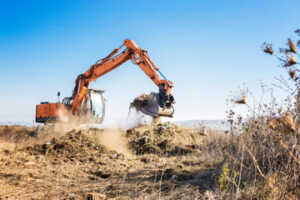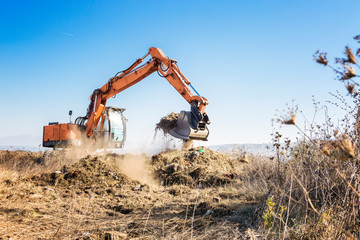Overgrown land is not only unsightly, but it also poses a fire hazard. It is essential to clear the land to protect homes and businesses from wildfires.
Land Clearing can be done in a sustainable manner by following local and environmental laws and regulations. This includes obtaining the proper permits and conducting environmental assessments.
In order to prepare a site for construction or agricultural purposes, land clearing involves removing trees, brush, and other vegetation. This process requires careful planning and attention to detail in order to achieve the desired results. Choosing the best method for clearing land depends on the size of the property, type of vegetation, and the intended use of the site. Land clearing can be done manually or mechanically, depending on the needs of the project.
One of the most important aspects of clearing land is ensuring that the area is safe and functional. Overgrown vegetation, fallen trees, and hidden debris can pose a serious threat to anyone using the area. In addition, it can cause problems for construction projects by limiting access to the building site or causing delays in completion. Land clearing removes these hazards and ensures that the construction site is free of obstructions.
The first step in the land clearing process is a thorough inspection of the property to determine the type and extent of vegetation that needs to be removed. This is also an opportunity to assess the soil conditions and identify any areas that may require special attention. Once the inspection is complete, a permit or clearance can be obtained to begin clearing the land.
Mechanical land clearing uses heavy machinery such as bulldozers and excavators to cut down and remove trees, brush, and other vegetation. This method is typically used for larger properties and is more efficient than manual clearing. It is also ideal for sites that require precision and control, such as those with delicate ecosystems or those with limited accessibility.
Chemical land clearing uses herbicides to kill unwanted plants and vegetation. This method is effective for clearing grass, weeds, and low-lying vegetation, but it isn’t suitable for removing large trees or thick brush. In addition, herbicides can have negative impacts on the environment and may harm wildlife and water quality.
Selective land clearing is a process that removes only the vegetation that is necessary for the construction project. It can save time, money, and resources while minimizing damage to the environment. It is also a good option for reducing fire hazards in areas that are prone to wildfires.
Equipment
Using proper land clearing equipment helps reduce ecological damage and increases efficiency. For example, skid steer tractors with mulching attachments can efficiently clear brush and save hours of manual labor. They also help avoid the need for costly hauling and landfill expenses. Choosing the right machinery depends on the type of project and the terrain, including steep slopes and rocky areas. The amount of vegetation on the site will also influence the complexity and cost of the clearing process. A specialized mulching machine is necessary for larger trees and stumps, while a backhoe or industrial tractor can clear bigger sections of land in one go.
The equipment used in land clearing is a complex combination of heavy and light machinery. Some of the most common include excavators, bulldozers, and mulchers. Some of these machines are available for rent or sale. However, it is a good idea to hire professionals with experience in clearing large areas of land. They will use proper safety and environmental protocols to ensure that the work is done in a way that protects wildlife habitats, prevents erosion, and minimises water runoff.
In addition to these machines, land clearing experts will often use herbicides to kill unwanted vegetation. This technique is less invasive than other methods and may be more effective for long-term vegetation control. It can be used in conjunction with other clearing methods or as a stand-alone method for more sensitive sites.
Aside from the heavy machinery, land clearing also requires a variety of smaller tools for cutting or breaking down debris and roots. These can include axes, chainsaws, and machetes. Axes are especially useful for tackling small branches and saplings, while machetes can cut thick underbrush and thorny vegetation.
Other important pieces of land clearing equipment include mowers and rotary cutters. These machines remove small vegetation and are ideal for clearing grass and weeds from residential and commercial properties. They can also be used to cut down and mulch tree stumps.
The choice of land clearing methods is determined by factors such as vegetation density, project size, and timelines. Experts will evaluate the specific project requirements to choose the best method. They will also provide a detailed plan, secure the appropriate permits, and prepare the area for machinery access to speed up the process. They will also decide on the most efficient means for dealing with debris, such as chipping on site, burning (where allowed), or hauling away.
Safety
The land clearing process poses a number of safety risks. It involves using power tools and machinery that can cause injuries if not used properly. Moreover, it requires climbing and working at heights. Therefore, it’s always better to hire a professional service provider with the right skills and equipment for clearing your property. They will make sure that all work is done safely and efficiently, minimizing the risk of accidents. It is also crucial to follow proper safety procedures and adhere to all environmental regulations.
Before starting any clearing activities, a thorough site inspection should be conducted to identify potential hazards. This will help in developing a clear safety plan that takes into account the specific needs of each project. The inspection should include identifying unstable trees, underground utilities, and any wildlife habitats that need to be protected. Moreover, it should also include implementing erosion control measures.
Land clearing is a necessary step in the preparation of a property for construction or agricultural use. Overgrown vegetation, fallen trees, and hidden debris can pose a serious threat to people and property. In addition, improper land clearing can lead to soil erosion and water pollution.
One of the biggest benefits of land clearing is that it can improve the overall quality of the land. This process removes dead or rotten vegetation, allowing for new growth and improved airflow. It also helps the soil retain moisture and nutrients. Moreover, it can reduce the risk of insect infestations by eliminating their breeding grounds.
Another benefit of land clearing is that it can increase the fire safety of communities and individual properties. In areas with dry climates, overgrown vegetation and accumulated debris can become significant fire hazards. However, professional land clearing services can help minimize fire risks by removing excess brush and reducing fuel load.
In addition, professional land clearing services can help protect homes and businesses from wildfires by ensuring that all buildings and structures are within a defensible space. They can also help reduce the risk of wildfires by reducing the amount of flammable material around buildings and removing dead or weakened trees.
Cost
Land clearing is an essential part of the site preparation process for construction and development projects. It creates a clean, level surface for building foundations and roads and helps ensure that the project is completed on time and within budget. It can also increase the value of a property by making it more attractive and appealing to potential buyers.
The cost of land clearing varies depending on the size, type, and density of vegetation on the site. For example, a plot with dense trees and thick brush will be more expensive to clear than flat land with less vegetation. The topography and terrain of the site can also affect costs, as sloping or hilly terrain can require specialized equipment and additional labor.
Another factor that influences land clearing costs is the availability of water. In areas with low rainfall, it may be more costly to clear the land because of the need to haul away water-saturated debris. Land clearing can also be more expensive during the rainy season, when soil conditions are slippery and equipment moves slower.
Local regulations and permitting requirements can also impact the cost of land clearing. For example, some areas require special permits for tree removal, and others have rules about protecting wetlands. These factors can add up to a significant amount of the total cost of land clearing.
Land clearing can be an environmentally friendly process if done correctly. For example, using manual clearing methods and rotational grazing can improve soil quality and biodiversity while reducing the need for heavy machinery. It is also important to use best practices for waste management and disposal.
There are a number of reasons why you might need to clear your land, including building a new commercial property or home. The process of removing vegetation from a piece of land can be expensive, but it’s worth the investment in the long run. It will improve the look of your property, attract more customers, and allow for future growth. Plus, it can help you avoid costly delays in construction and compliance issues.

